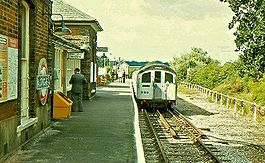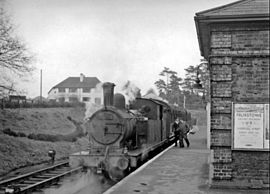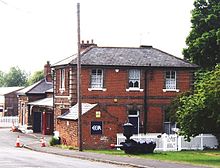- Ongar railway station
-
Ongar 
Location Place Chipping Ongar Area Epping Forest Coordinates 51°42′32″N 0°14′34″E / 51.7089°N 0.2428°ECoordinates: 51°42′32″N 0°14′34″E / 51.7089°N 0.2428°E Grid reference TL550034 Operations Original company Great Eastern Railway Pre-grouping Great Eastern Railway Post-grouping London and North Eastern Railway Operated by Epping Ongar Railway Platforms 1 History 24 April 1865 Station opened 25 September 1949 Transferred to LT Central Line 18 November 1957 Electrified 18 April 1966 Goods yard closed[1] 30 September 1994 Station closed November 2004 Reopened in preservation Stations on heritage railways in the United Kingdom A B C D E F G H I J K L M N O P Q R S T U V W X Y Z Ongar tube station is a former London Underground station in the town of Chipping Ongar, Essex. Until its closure in 1994, it was the easternmost point of the Central line, and from 1961 until closure, it held the distinction of being the London Underground station farthest from Central London.[2]
Contents
History
The station was opened by the Eastern Counties Railway on 24 April 1865,[3] serving principally as a goods station taking agricultural produce from the nearby farms into central London. On 29 September 1949, London Underground services took over the operation of the station from British Railways when services were extended from Loughton.[3]
Although the rest of the branch was electrified by London Underground before operations were taken over from British Railways, trains on the section north of Epping continued to be hauled by steam locomotives as a separate shuttle service. The service was operated by British Railways for the Underground until 18 November 1957, when the line was electrified and electric trains took over from steam.[4] A shortage of power prevented the Epping to Ongar section being fully integrated into the line and it continued to operate as a shuttle service.[5]
The entire Epping to Ongar branch was a single track line with one passing place at North Weald station, although this loop was taken out of service in 1976. Until then two trains could use the branch, although they were limited to four cars in length because of the restriction on the available traction current. The service was reduced to one train after the southbound track at North Weald was lifted. It was therefore never suitable for heavy use, and the line was reportedly never profitable. For much of its latter years, the service only operated during Monday to Friday peak hours, and London Transport closed Blake Hall station, the least used on the entire system, in 1981. The line itself continued in use and there was a brief re-introduction of all day services in 1990. However, a system wide cost-cutting exercise saw the service return to peak hours soon afterward, with an even more skeletal service than before. The line was under threat of closure for many years, and it was finally closed on 30 September 1994.
Epping Ongar Railway
Main article: Epping Ongar RailwayThe station and the line are now in the ownership of a private company, the Epping Ongar Railway Ltd who, at time of purchase, publicly stated their intention to run commuter services again, but the claimed lack of platform availability at London Underground's Epping station at the west end of the line has to date proven an insuperable obstacle to this. The Epping Ongar Railway Volunteer Rail Society ran heritage trains on Sundays over the former Epping and Ongar line from 2004 until 2007.[6]
Ongar Station, as with the rest of the 6.5 mile branch reaching to the outskirts of Epping station, is currently undergoing significant improvement and infrastructure works. These are designed with the long term future of the branch and to enable the use of locomotive hauled trains (hauled by steam and diesel locomotives), all in keeping with its use as a heritage railway. The station itself has been extensively restored by the teams of volunteers, with all the rooms being restored to their original layouts, opening up bricked up doorways and windows, and restoring the station back to Great Eastern Railway colours (believed to be the only original operational GER station in its original colours). Within the station the former Parcel's Office will be a museum and educational display. In addition an original GER signalbox (originally from Spelbrook) has been rescued and placed to replace the original signalbox which was demolished by LU in the 1980's, and the platform is being improved to facilitate access.
Other information
The sand drag at the very end of the rails — intended to help slow trains that overshot the stopping mark — was said to be home to a breed of harmless scorpion and featured in a 1979 episode of the BBC's Wildlife on One. They had been released there by the station foreman who was a keeper of exotic pets.[7]
Although the station is no longer owned by London Underground, all distances on the network are still measured from Ongar.[8]
The Royal Navy's Tigerfish torpedo was known as Project ONGAR during development.[9] It was named after the station as the engineers hoped their new weapon would be "...the end of the line for torpedo development".
See also
References
- Notes
- ^ Hardy 2011, pp. 175-183.
- ^ Before 1961, the Metropolitan line's north-western terminus at Aylesbury was the most distant. After Ongar's closure, the most distant is the Metropolitan line's Chesham
- ^ a b Feather, Clive (31 March 2011). "Central Line, Dates". Clive's Underground Line Guides. http://www.davros.org/rail/culg/central.html#dates. Retrieved 18 March 2008.
- ^ Lee 1970, p. 31.
- ^ Feather, Clive (31 March 2011). "Central Line, History". Clive's Underground Line Guides. http://www.davros.org/rail/culg/central.html#history. Retrieved 18 March 2008.
- ^ Skinner, Paul (2011). "Epping Ongar Railway". http://www.eorailway.co.uk/. Retrieved 5 July 2010.
- ^ Lyons, James (20 January 2007). "Epping Ongar Railway History - Ongar station". http://www.eohistory.bravehost.com/few.html. Retrieved 22 May 2011.
- ^ Feather, Clive (2 April 2011). "Introduction - Kilometrage". Clive's Underground Line Guides. http://www.davros.org/rail/culg/intro.html. Retrieved 22 May 2011.
- ^ Public Record Office ADM 290/289
- Bibliography
External links
- Feather, Clive. "Central Line". Clive's Underground Line Guides. http://www.davros.org/rail/culg/central.html. Retrieved 18 March 2008.
- Lyons, James (20 January 2007). "Epping Ongar Railway History". Epping Ongar Railway History. http://www.eohistory.bravehost.com/index.html. Retrieved 22 May 2011.
- Skinner, Paul (2011). "Epping Ongar Railway". http://www.eorailway.co.uk/. Retrieved 5 July 2010. Epping Ongar Railway's Official Website
- London Transport Museum Photographic Archive
- London's Abandoned Tube Stations - Ongar station
- London's Abandoned Tube Stations - Epping to Ongar branch
Preceding station  Heritage railways
Heritage railwaysFollowing station North Weald Epping Ongar Railway Terminus Disused railways Preceding station  London Underground
London UndergroundFollowing station towards EppingCentral line Epping-Ongar branchTerminus Central line Stations Bank · Barkingside · Bethnal Green · Bond Street · Buckhurst Hill · Chancery Lane · Chigwell · Debden · Ealing Broadway
· Barkingside · Bethnal Green · Bond Street · Buckhurst Hill · Chancery Lane · Chigwell · Debden · Ealing Broadway  · East Acton · Epping · Fairlop · Gants Hill · Grange Hill · Greenford
· East Acton · Epping · Fairlop · Gants Hill · Grange Hill · Greenford  · Hainault · Hanger Lane · Holborn · Holland Park · Lancaster Gate · Leyton · Leytonstone · Liverpool Street
· Hainault · Hanger Lane · Holborn · Holland Park · Lancaster Gate · Leyton · Leytonstone · Liverpool Street  · Loughton · Marble Arch · Mile End · Newbury Park · North Acton · Northolt · Notting Hill Gate · Oxford Circus · Perivale · Queensway · Redbridge · Roding Valley · Ruislip Gardens · St Paul's · Shepherd's Bush
· Loughton · Marble Arch · Mile End · Newbury Park · North Acton · Northolt · Notting Hill Gate · Oxford Circus · Perivale · Queensway · Redbridge · Roding Valley · Ruislip Gardens · St Paul's · Shepherd's Bush 
 · Snaresbrook · South Ruislip · South Woodford · Stratford
· Snaresbrook · South Ruislip · South Woodford · Stratford 

 · Theydon Bois · Tottenham Court Road · Wanstead · West Acton · West Ruislip
· Theydon Bois · Tottenham Court Road · Wanstead · West Acton · West Ruislip  · White City · Woodford
· White City · Woodford

Click to enlargeRolling stock History Former stationsFormer companiesAbandoned plansFormer rolling stockProposed stations First Central · UxbridgeCategories:- Disused London Underground stations
- Heritage railway stations in Essex
- Transport in Epping Forest
- Former Great Eastern Railway stations
- Railway stations opened in 1865
- Railway stations closed in 1994
- Railway stations opened in 2004
- Former single platform tube stations
- Epping Ongar Railway
Wikimedia Foundation. 2010.



